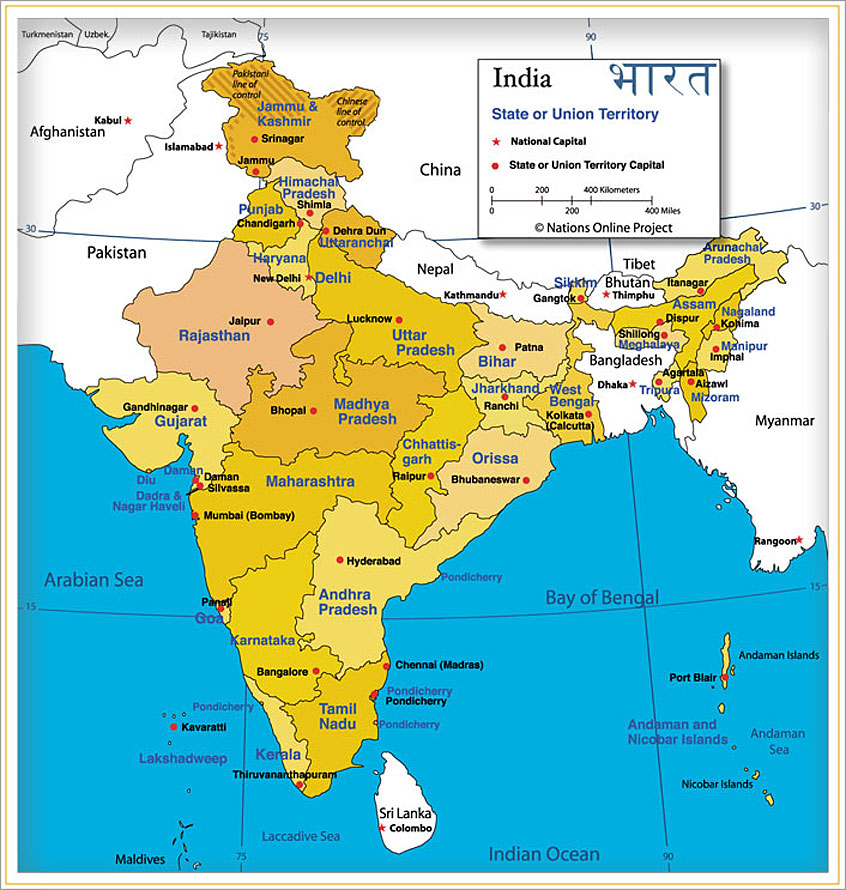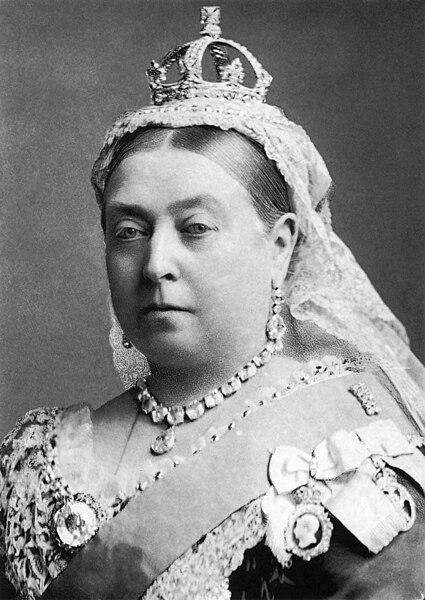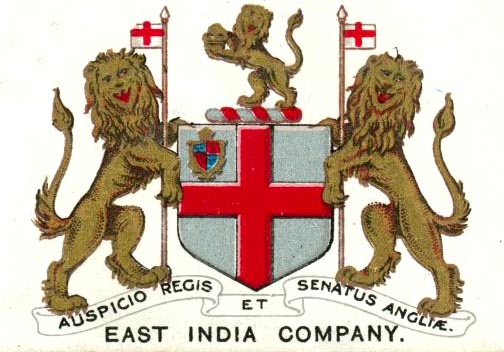Republic of India Bharat Ganrajya | ||||||
|---|---|---|---|---|---|---|
| ||||||
India, officially the Republic of India (Bharat Ganrajya), is a country in South Asia. It is the seventh-largest country by area, the second-most populous country with over 1.2 billion people, and the most populous democracy in the world. Bounded by the Indian Ocean on the south, the Arabian Sea on the south-west, and the Bay of Bengal on the south-east, it shares land borders with Pakistan to the west; China, Nepal, and Bhutan to the north-east; and Burma and Bangladesh to the east. In the Indian Ocean, India is in the vicinity of Sri Lanka and the Maldives. Its capital is New Dheli and its most populated city Mumbai. The official languages are English and Hindi, and the official currency is the Indian rupee.


flag emblem
Sometimes it is referred to as 'the subcontinent'. Used on its own in English, this phrase includes the countries of India, Pakistan, Bangladesh, Nepal, Bhutan, Maldives and Sri Lanka. The region largely comprises a peninsula
of Asia south of the Himalayas and constitutes a geoculturally distinct
region within Asia. The region contains desert, plateau, rain forest, mountains and a myriad of languages, races, and religions.
Four world religions—Hinduism, Buddhism, Jainism,
and Sikhism—originated here, whereas Judaism, Zoroastrianism, Christianity, and Islam arrived in the 1st
millennium CE and also helped
shape the region's diverse culture. Buddhism is based on teachings attributed to Siddhartha Gautama, who shared his insights to help sentient beings end their suffering through the elimination of
ignorance by way of understanding and the
seeing of dependent origination and the
elimination of desire, and thus the attainment of the
cessation of all suffering, known as the sublime state of nirvāņa.
Hinduism is the oldest religion in the world and the third most practised faith after Christianity and Islam. Major scriptures include the Vedas, Upanishads, Mahabharata, Ramayana, and Bhagavad Gita. Hindu deities include Visnu, Shiva and Ganesha the elephant.
The river Ganges is regarded as the most sacred river for Hindus and Diwali, the festival of lights, is one the most important festivals of the year. It is celebrated between October and November, all the celebrants wear new clothes and share sweets and snacks with family members and friends. Special lamps are kept on during the night and one's house is cleaned in order to make the goddess Lakshmi feel welcome. Firecrackers are burst because it is believed that it drives away evil spirits. Most Indian business communities begin their financial year.
By the early 18th century, with the lines between commercial and political dominance being increasingly blurred, a number of European trading companies, including the English East India Company, had established coastal outposts. The Portuguese settled in Goa and the French in Chandernagor, Pondichéry, Karikal or Mahé. The East India Company's control of the seas, greater resources, and more advanced military training and technology led it to increasingly flex its military muscle and caused it to become attractive to a portion of the Indian elite; both these factors were crucial in allowing the Company to gain control over the Bengal region by 1765 and sideline the other European companies. Its further access to the riches of Bengal and the subsequent increased strength and size of its army enabled it to annex or subdue most of India by the 1820s. India was then no longer exporting manufactured goods as it long had, but was instead supplying the British empire with raw materials, and many historians consider this to be the onset of India's colonial period. By this time, with its economic power severely curtailed by the British parliament and itself effectively made an arm of British administration, the Company began to more consciously enter non-economic arenas such as education, social reform, and culture. Queen Victoria (1819-1901) adopted among her titles that of "Empress of India".
Historians consider India's modern age to have begun sometime between 1848
and 1885. The appointment in 1848 of Lord Dalhousie as
Governor General of the East India Company set the stage for
changes essential to a modern state. These included the consolidation and
demarcation of sovereignty, the surveillance of the population, and the education of citizens. Technological
changes—among them, railways, canals, and the telegraph—were introduced not long
after their introduction in Europe.
The British Raj was the British rule in the Indian subcontinent between 1858 and 1947. The term can also refer to the period of dominion of the region under British control. However, disaffection with the Company also grew during this time, and set off the Indian Rebellion of 1857. Fed by diverse resentments and perceptions, including invasive British-style social reforms, harsh land taxes, and summary treatment of some rich landowners and princes, the rebellion rocked many regions of northern and central India and shook the foundations of Company rule. Although the rebellion was suppressed by 1858, it led to the dissolution of the East India Company and to the direct administration of India by the British government. Proclaiming a unitary state and a gradual but limited British-style parliamentary system, the new rulers also protected princes and landed gentry as a feudal safeguard against future unrest. In the decades following, public life gradually emerged all over India, leading eventually to the founding of the Indian National Congress in 1885.
The British Raj was the British rule in the Indian subcontinent between 1858 and 1947. The term can also refer to the period of dominion of the region under British control. However, disaffection with the Company also grew during this time, and set off the Indian Rebellion of 1857. Fed by diverse resentments and perceptions, including invasive British-style social reforms, harsh land taxes, and summary treatment of some rich landowners and princes, the rebellion rocked many regions of northern and central India and shook the foundations of Company rule. Although the rebellion was suppressed by 1858, it led to the dissolution of the East India Company and to the direct administration of India by the British government. Proclaiming a unitary state and a gradual but limited British-style parliamentary system, the new rulers also protected princes and landed gentry as a feudal safeguard against future unrest. In the decades following, public life gradually emerged all over India, leading eventually to the founding of the Indian National Congress in 1885.
The railway network provided critical famine relief, notably reduced the cost of moving goods, and helped nascent Indian-owned industry. After World War I, in which some one million Indians
served, a new period began. It was marked by British reforms but also repressive
legislation, by more strident Indian calls for self-rule, and by the beginnings
of a non-violent movement of non-cooperation, of which Mohandas Karamchand Gandhi would
become the leader and enduring symbol.
During the 1930s, slow legislative reform was enacted by the British; the Indian
National Congress won victories in the resulting elections. The next decade was beset with crises: Indian participation in World War II, the
Congress's final push for non-cooperation, and an upsurge of Muslim nationalism.
All were capped by the advent of independence in 1947, but tempered by the partition of
India into two states: India and Pakistan.
Vital to India's self-image as an independent nation was its constitution,
completed in 1950, which put in place a secular and democratic republic. In the 60 years since, India has had a mixed record of successes and
failures. It has remained a democracy with civil liberties, an activist Supreme Court, and
a largely independent press. Economic liberalisation, which was begun in the 1990s, has created a large urban
middle class, transformed India into one of the world's
fastest-growing economies, and increased its geopolitical clout. Indian movies, music, and spiritual
teachings play an increasing role in global culture. Yet, India has also been weighed down by seemingly unyielding poverty, both
rural and urban; by religious and caste-related violence; and by separatism in Jammu and Kashmir
and in Northeast India. It has unresolved territorial disputes with China and with Pakistan, which flared into wars fought in 1947, 1965, 1971, and 1999. The India–Pakistan nuclear rivalry came to a head in 1998. India's sustained democratic freedoms are unique among the world's new nations;
however, in spite of its recent economic successes, freedom from want for its
disadvantaged population remains a goal yet to be achieved.
Indian emigration is an ancient phenomenon. The most significant historical emigration from India was that of the Romani people, traditionally known by the term "Gypsies". Linguistic and genetic evidence indicates the Romani originated from the Indian subcontinent, emigrating from India towards the northwest no earlier than the 11th century. The Romani are generally believed to have originated in central India, possibly in the modern Indian state of Rajasthan, migrating to northwest India (the Punjab region) around 250 B.C.
During the 19th century and until the end of the British Raj, much of the migration that occurred was of poor workers to other British colonies under the indenture system. The major destinations, in chronological order, were Mauritius, Guyana, the Caribbean, Fiji, and East Africa.
Most Asians in South Africa are descended from indentured Indian labourers who were brought by the British from India in the 19th century, mostly to work in the sugar cane plantations. A minority are descended from Indian traders who migrated to South Africa at around the same time, many from Gujarat. The city of Durban has the highest number of Asians in sub-Saharan Africa, and the Indian independence leader Mahatma Gandhi worked as a lawyer in the city in the early 1900s. South Africa in fact has the highest number of people of Indian descent outside of India in the world, i.e. born in South Africa and not migrant, compared to the U.S. Most of them are fourth to fifth generation descent. Most Indian South Africans do not speak the Indian languages which were 'lost' over the generations, although they do enjoy watching Indian movies and listening to Indian music.
Indian emigration is an ancient phenomenon. The most significant historical emigration from India was that of the Romani people, traditionally known by the term "Gypsies". Linguistic and genetic evidence indicates the Romani originated from the Indian subcontinent, emigrating from India towards the northwest no earlier than the 11th century. The Romani are generally believed to have originated in central India, possibly in the modern Indian state of Rajasthan, migrating to northwest India (the Punjab region) around 250 B.C.
During the 19th century and until the end of the British Raj, much of the migration that occurred was of poor workers to other British colonies under the indenture system. The major destinations, in chronological order, were Mauritius, Guyana, the Caribbean, Fiji, and East Africa.
Most Asians in South Africa are descended from indentured Indian labourers who were brought by the British from India in the 19th century, mostly to work in the sugar cane plantations. A minority are descended from Indian traders who migrated to South Africa at around the same time, many from Gujarat. The city of Durban has the highest number of Asians in sub-Saharan Africa, and the Indian independence leader Mahatma Gandhi worked as a lawyer in the city in the early 1900s. South Africa in fact has the highest number of people of Indian descent outside of India in the world, i.e. born in South Africa and not migrant, compared to the U.S. Most of them are fourth to fifth generation descent. Most Indian South Africans do not speak the Indian languages which were 'lost' over the generations, although they do enjoy watching Indian movies and listening to Indian music.
Indian migration to the modern countries of Kenya, Uganda and Tanzania started nearly a century ago when these were
part of British East Africa. Their number may have been as high as 500,000 in the 1960s.
Indian-led businesses were (or are) the backbone of the economies of these
countries. These ranged in the past from small rural grocery stores to sugar mills. In
addition, Indian professionals, such as doctors, teachers, engineers, also played an important part in the
development of these countries. After independence from Britain in the 1960s,
the majority of Asians, as they were known, moved out or were forced out
from these countries (in 1970's by Idi
Amin in Uganda). Most of them moved
to Britain, or India, or other popular
destinations like the USA
and Canada.
The Indian emigrant community in the United Kingdom is now in its third
generation. Indians in the UK are the largest community outside of Asia proportionally, and the second largest in terms of
population, only surpassed by the United States, and closely followed by Canada. The first wave of Indians in the
United Kingdom worked as manual labourers and were not respected within society.
However, this has changed considerably. Third and fourth generation immigrants
are on the whole proving to be very successful, especially in the fields of law,
business and medicine.
Indian culture has been constantly referenced within the wider British culture, at first as an "exotic" influence in films like My Beautiful Laundrette, but now increasingly as a familiar feature in films like Bend It Like Beckham.
Freddy Mercury, leader of the band Queen, was born in Zanzibar of Parsi descent and grew up in India
Indian culture has been constantly referenced within the wider British culture, at first as an "exotic" influence in films like My Beautiful Laundrette, but now increasingly as a familiar feature in films like Bend It Like Beckham.
After the 1970s oil boom in the Middle East, numerous Indians emigrated to work in
the Gulf countries. With modern transportation and expectations, this was on a
contractual basis rather than permanent as in the 19th century cases. These Gulf
countries have a common policy of not naturalizing non-Arabs, even if they are
born there.
The 1990s IT boom and rising economy in the USA attracted numerous Indians who emigrated to the United
States of America. Today, the USA has the third largest number of Indians.
India and the British experience there was portrayed by writers like Rudyard Kipling (Kim, The Jungle Book), E.M. Foster (A Passage to India), Ruth Prawer Jhabvala (Heat and Dust), in the same way as writers like Saki and Orwell wrote about their experience in Burma. Many of these novels have been made into movies. Famous Indian writers in English are also Salman Rushdie (Midnight's Children, The Satanic Verses), Arundati Roy (The God of Samll Things), Anita Desai (Fire on the Mountain), Rohinton Mistry (Family Matters), Vikram Seth (A Suitable Boy), or Aravind Adiga (The White Tiger).
The cinema also deserves special mention. Apart from the Bollywood phenomenon, famous Indian directors are Mira Nair (Salaam Bombay!, Mississippi Masala, Monsoon Weeding, Kama Sutra. A Tale of Love, The Reluctant Fundamentalist), Deepa Mehta (Fire, Earth, Water, Midnight's Children) or Gurinder Chadha (Bend it Like Beckham, Bride and Prejudice).
India and the British experience there was portrayed by writers like Rudyard Kipling (Kim, The Jungle Book), E.M. Foster (A Passage to India), Ruth Prawer Jhabvala (Heat and Dust), in the same way as writers like Saki and Orwell wrote about their experience in Burma. Many of these novels have been made into movies. Famous Indian writers in English are also Salman Rushdie (Midnight's Children, The Satanic Verses), Arundati Roy (The God of Samll Things), Anita Desai (Fire on the Mountain), Rohinton Mistry (Family Matters), Vikram Seth (A Suitable Boy), or Aravind Adiga (The White Tiger).
The cinema also deserves special mention. Apart from the Bollywood phenomenon, famous Indian directors are Mira Nair (Salaam Bombay!, Mississippi Masala, Monsoon Weeding, Kama Sutra. A Tale of Love, The Reluctant Fundamentalist), Deepa Mehta (Fire, Earth, Water, Midnight's Children) or Gurinder Chadha (Bend it Like Beckham, Bride and Prejudice).
India has also attracted Western directors like Rolan Joffé (City of Joy) or Danny Boyle (Slumdog Millionaire)







